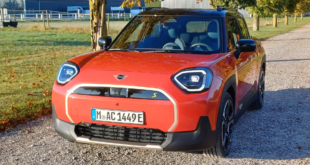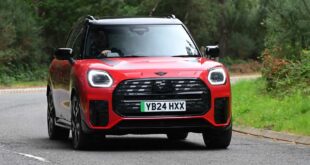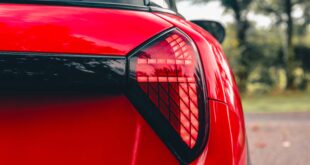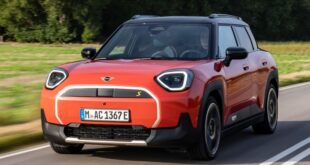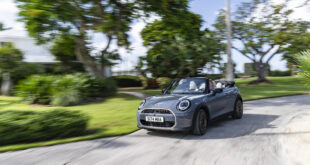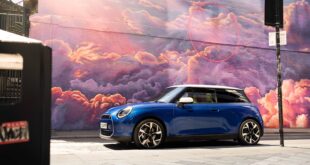Usually, it takes an entire article’s worth of reading before reviewers such as yours truly would give you a verdict on whichever car we were testing. But, I’m going to say it here first. The Mini Electric is so compelling to me that hand on heart if I had the finances to buy one (and if the GR Yaris didn’t exist), I would. There is a caveat though, it’s not for everyone.

The last time I drove a Mini Electric, it wasn’t that long ago. But because Mini gave their entire range a fresh new facelift, I had the pleasure of taking this little electrifying hatch out once again. So what has changed?

From the outside, the most obvious change is that new bearded front visage. While it might look a little comical when viewed on its own, it actually blends rather well with the rest of the car when taken in as a whole. The new Mini E has also ditched the front fog lamps for a pair of slim vertical intake slats which through some aerodynamic magic allows for better efficiency all around. Elsewhere, the funky and iconic exterior design remains largely identical to the Mini E I previously drove, which really isn’t a bad thing.


Inside, the interior trim has been refreshed with even more expressive graphical elements across the dash, the feelsome new steering wheel has been redesigned with newer BMW-esque gloss-black buttons with the Mini Electric logo prominently showing on its base and the central infotainment screen is now a generous 8.8-inches across encompassed within a redesigned illuminated bezel in place of the predecessor’s singular light strip.


More importantly, the entire user interface has also been redesigned with a lighter, cleaner and more modern looking layout. With a myriad of options to toggle through, it does once again take some getting used to and its light coloured background does tend to wash out some of the white text under strong sunlight. Also, while it has been updated, it still does not yet feature BMW’s very intuitive speech-recognition assistant.

The Mini E also retains its very clear and legible digital speedometer but I feel this could have also benefited from a slight tweak for the Mini E in particular by giving the remaining range more visual prominence. Currently, the range numbers look a little small for something that’s so very important when it comes to driving an EV.

A simple solution will be to shift that range meter closer to the battery readout for better association and easier reading whilst on the move. Hopefully, they will fix it with the new iteration.

Elsewhere, true to the marque’s playful nature, the Mini E also has what they call a “Mini-malism analyser” to liven up your drive should you choose to settle down into a “Green” driving mode. This little game grades you on how smooth you are when it comes to driving economically. Interestingly, there is also a “Green+” mode that shuts down all the non-essential bits to limp you home or to a charger. Let’s hope you wouldn’t use it.



While boot space is fairly decent and more than adequate with the rear seats folded down, the Mini Electric is a car best enjoyed by two as space in the back is not exactly capacious and there might be complaints should you choose to stuff full-grown adults behind.

With the Mini E, I did something I’ve not yet done when testing an EV, I woke myself up at the ungodly hour of 5 am on a lovely dry Saturday for an early morning’s worth of senseless driving with nowhere in particular to go, all for those few electrifying moments whizzing up and down my favourite twisty road with the sunroof fully extended and the windows down. With little to no noise generated, it’s the joy of driving without any public persecution.

A joy to drive through meandering passes, a joy to drive darting through traffic and even a joy to just drive around the neighbourhood. A joy simply because of its powertrain.
A powertrain which on paper, doesn’t seem all that impressive to warrant such praise. 184hp, 270Nm of torque, and a 0-100km/h acceleration time of 7.3 seconds. Nothing to scoff at but, pretty much standard mildly-e-hot hatch numbers right? Well, yes and no, because while those numbers are not particularly mind-bending figures, it is the way the Mini E serves them up which make for such an enjoyable drive.

Those 270 Newton Metres? They arrive instantaneously. That 7.3 second century sprint? You can hit it every single time at pretty much every single stoplight, no fuss, no drama. No bouncing off the rev-limiter, no clutch-dumping and no launch control systems to toggle though, just ease the throttle down towards the floor and every other car will suddenly become smaller in your rearview mirror. While it might not be the quickest car out there on paper, in real life, with full power so easily accessed, it’s a real contender. Say what you want about EVs but get behind the wheel of one of these and I’m pretty sure boring won’t be part of your list of complaints.


On busy roads, that same instantaneous power also provides a seamless surge of power whenever required and coupled with the Mini E’s very responsive and direct steering allows for some quick rapid progress through little pockets in traffic where larger cars can only dream of slotting into.
This seamless surge of power also translates into a confidence-inspiring drive through the bends because with no mid-corner gear-shifts causing unwanted weight balance shifts and with the batteries placement allowing for a rather low centre of gravity, there is little drama when putting down of power as you sweep silently through a bend.

Regenerative braking on the Mini E also plays a part when it comes to corner-carving duties as it can transition from a smooth reduction in speed to hauling the Mini E down to a standstill on throttle control alone. Unfortunately, while grip through those 17-inch Pirelli P7s is excellent they do transmit quite a bit of road noise on the highways.
Another area that also takes some getting used to is the steering. It might be quick and responsive, but with no engine to haul around, the little minute vibrations one gets from piloting a dinosaur-juice drinking vehicle has been eliminated, taking away a small layer of tactility from the already numb on-centre steering feel of the Mini E.

That smile-inducing handling does come with a trade-off in the form of a rather stiff ride quality. While the suspension does a good job at soaking away the harshness of most road imperfections, they also do a very good job informing you non-stop exactly what it is they’re doing. While all these issues are worth mentioning, the fact remains that for someone who enjoys driving, they aren’t dealbreakers.
What could possibly be a dealbreaker though has to do with something that’s not even within the scope of Mini’s engineers. Charging points.

While the actual range of the 32.64kWh battery varies greatly on a number of factors, the range displayed on the Mini E’s readout is by and large quite accurate and on some occasions during my drive, even pessimistic as I’ve encountered situations where I arrive at my destinations with almost the same amount of range as I started out with. Drive it in “Green” mode and I even gained a couple of kilometres at the end of my journey! On a full charge, you can get between 150-170km easily driving on our local roads.
While this talk of the Mini E’s delightful driving ability is fine and dandy, 150-170km while good enough, will not allow you the luxury of plugging in at the end of the week. In order to get the best ownership experience out of a Mini E, you must have a charger installed at home. There are no two ways about it. What about the much-publicised public chargers? In all honestly, they are not yet enough and if you need to use them to keep your car juiced up, you will need to plan your days around these few available public chargers.
The way I see it, having a charging port at home solves two big issues, physical range and mental psychological range. The first I’ve already explained, the second is something that I’ve experienced first hand. Having driven the previous Mini E without a charging system at home, I’ve always had to mentally keep track of my range and at the same time plan my day around an available charger outside, while this might not seem like that big of a deal, it does take a toll on enjoying the car to its fullest potential as I’ve always had to constantly watch my driving lest I waste a precious kilometre.

This time though, with a charging point available at home (to accompany our plug-in hybrid), this mental anguish and psychological barrier is all but gone and I had the freedom to call upon the Mini Electric’s playful eclectic nature anytime, anywhere.

The last time I drove the Mini E back in December 2020, its list price was S$169,888, a slight S$4,000 premium over its petrol Cooper-S equivalent. This new one? Even after accounting for today’s slightly higher COE Cat B premium, lists at a slightly lower S$168,888 (as of writing). Undercutting the Cooper S 3-Door (S$193,888) and even the standard Cooper 3-Door (S$176,888).
Even more reason to rock down to electric avenue don’t you think? Here’s the address, 27 Leng Kee Road. If I could, I’d join you.
 BMW.SG | BMW Singapore Owners Community The Ultimate BMW Community – Established Since 2001
BMW.SG | BMW Singapore Owners Community The Ultimate BMW Community – Established Since 2001


